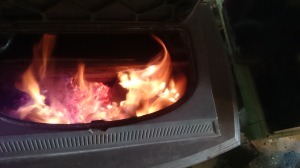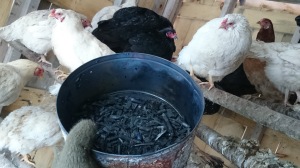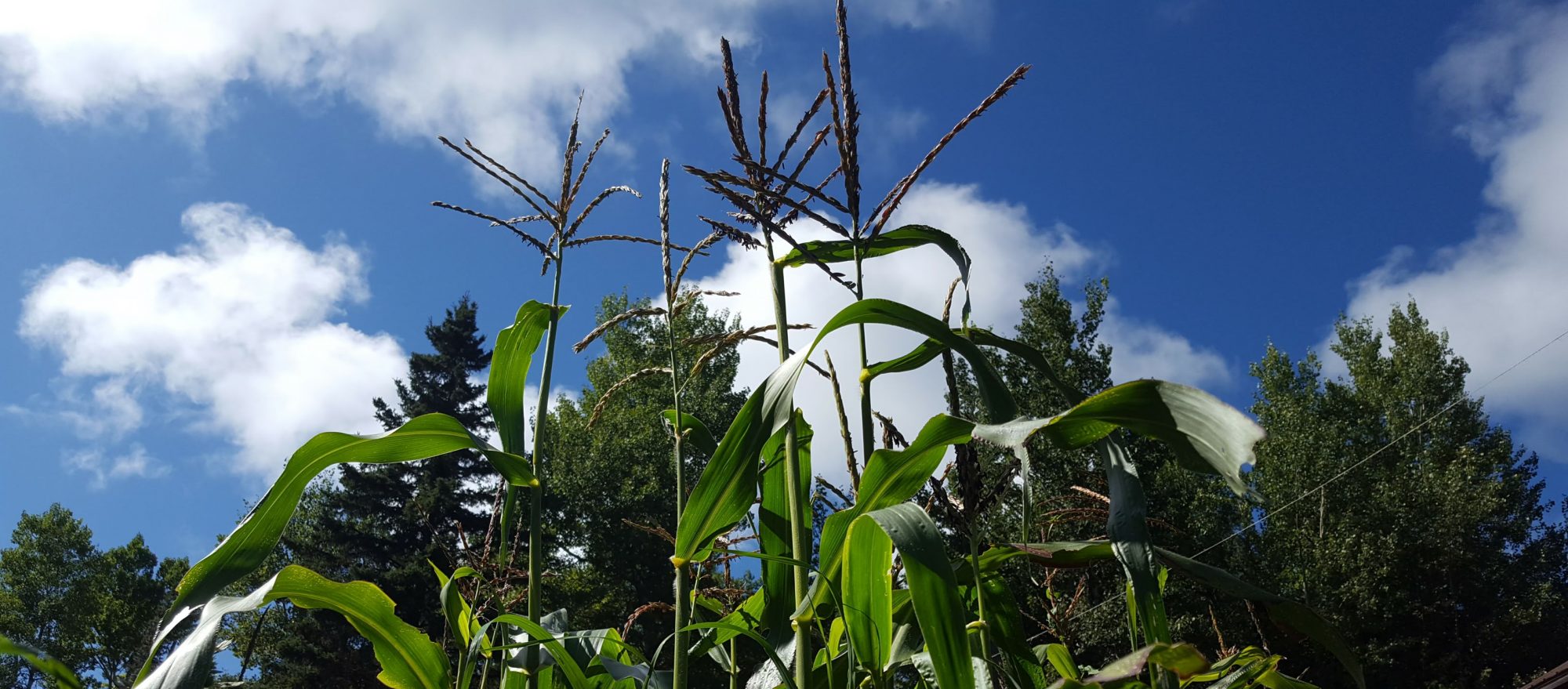
By: Kaare Melby
April 20th, 2015
Winter’s cold embrace has a way of inspiring ingenuity here on Finnskogen farm, and this winter was no exception. On one particularly cold day this February, I was sitting next to the woodstove, day-dreaming about all of the projects that the frozen ground and snow were preventing me from working on, when I had an idea that changed the way I thought about our woodstove, and our whole farm.
One of the projects I had been working on over the summer was ways to efficiently make Biochar to add to our compost. Biochar is charcoal, which can be made from any biomass (grass, leaves, wood, sawdust, manure, food waste, egg shells, bones, etc). When used properly, Biochar has amazing properties that can drastically improve agricultural soils. It can help increase the population of healthy soil micro-organisms, it can increase water retention in soils, and it can be a great way to fix nutrients in the soil. But the benefits are not limited to agriculture; Biochar can actually help us fight climate change by fixing carbon in the soil for thousands of years! Clearly, Biochar is something of interest to us.
But I ran into some problems when I was contemplating ways to make Biochar on our farm. I tried the pit method, which involved starting wood on fire, then slowly burying it as it burned. This method was labor intensive, and it seemed pretty inefficient. It also ended up with a lot of sand/dirt mixed in with the Biochar, which made retrieving the Biochar difficult. Next I tried making a pyrolysis chamber out of a metal bucket. This resulted in a much cleaner finished product. But this method was still somewhat labor-intensive, as it required me to gather a lot of firewood to support the large fire the processes needed. This also bothered me because it required me to burn a lot of wood that I otherwise might not have burned, and burning this wood only achieved one goal: making biochar. I knew there had to be a better way, but I wasn’t sure what it was.
This is where the woodstove comes in. What if I used the fire in my woodstove to make Biochar? The idea is simple enough, but the effects really started to inspire me. There are many people across the planet who heat their homes using a woodstove. If I could figure out a simple, cheap, and efficient way to use a woodstove to simultaneously make heat and Biochar, I could teach other people the method. And if enough of us started making and using Biochar regularly, we could make a real impact on climate change (not to mention improve our soils and grow more healthy food for our community)!


After thinking about it for a while, I realized that all I needed was a pyrolysis chamber that fit into the woodstove, and still left enough room for a fire to burn. A pyrolysis chamber is really just a metal container with a lid and vent holes on the bottom. I made a simple one out of an old round cookie tin (thrift stores often have these for sale if you don’t have any laying around). I used an awl to poke holes along the side of the tin, filled it with wood scraps, and wrapped it with some steel wire to hold the lid on. I then put the filled tin into my woodstove on top of a hot bed of coals. I added some wood to the fire and shut the stove.

After about half an hour I opened up the stove, and saw the sign of successful gasification that I was looking for: jets of flames coming out of the vent holes in the side of the tin. After an hour or two the gasification stopped, the fire burned down, and I removed the tin and put it outside to cool (This is very important! If you do not let the Biochar cool down before opening the pyrolysis chamber, the Biochar can ignite, burning up all of that carbon you have worked so hard to preserve). Once the Biochar had completely cooled, I opened the tin, crunched up the pieces, and sprinkled them on to the floor of my deep litter chicken coop. This helps inoculate the Biochar with good bacteria and nutrients such as nitrogen. It also helps keep the chicken coop from smelling bad. If you don’t have a chicken coop, we suggest that you mix your Biochar in to your compost pile, or at least leave it outside to weather for a while before incorporating it in to your garden. The Biochar needs to absorb some water and nutrients first; otherwise it can actually suck important nutrients out of your soil.
Note: I have noticed that some cookie tins start to disintegrate after several uses. Some tins are stronger than others; I suggest looking for a pretty sturdy one. I plan on having my local welder make a pyrolysis chamber for me out of some heavier duty sheet metal for next year. But for now I am happy using the cookie tin.
Wait, doesn’t burning wood release carbon in to our atmosphere?
Yes, anytime you burn carbon based materials, some carbon is released in to the atmosphere. But there is a difference between wood and fossil fuels such as petroleum and coal. When we burn fossil fuels we are adding ancient carbon in to the current carbon system. That carbon took a very long time to accumulate via natural processes, and it’s been stored safely underground for millions of years. When we burn wood, we are adding some carbon to the atmosphere, but that carbon is part of the current carbon system. When a tree grows, it pulls carbon out of the atmosphere using photosynthesis. When that tree dies, most of that carbon will return to the atmosphere in the decomposition processes. When you burn wood, you simply accelerate that processes. In this way, wood is essentially carbon neutral, because it does not add new carbon in to the atmosphere.
Even though burning wood does not add new carbon to the atmosphere, it does add some carbon to the atmosphere. And for this reason, I like to avoid burning wood when I can. That is why I am so excited about making Biochar using the fire in my woodstove, a fire that would burn whether I was making biochar or not. Using the woodstove also helps burn off the volatile gasses that are produced when making biochar (remember those jets of flame that were coming out of the vents in the pyrolysis chamber?). As those volatile gasses are burned, they generate heat. This means that we are producing heat for our home as a byproduct of making Biochar. And we take the Biochar (which is pure carbon), and add it to the soil, where it can stay for thousands of years. This means we use carbon from the current carbon system to create a stable form of carbon that is essentially removed from the current carbon system. And that is the secret to reversing climate change.
Now that you have this knowledge, it’s up to you to act on it. We all need to start making biochar. We all need to teach others about biochar. And we all need to spread this message of hope! We can reverse climate change! It’s up to all of us!

Great information!
LikeLiked by 1 person
It seems one should do a PH test before adding to the soil. This can make soil highly alkaline.
LikeLike
It’s actually ash that would increase soil alkalinity. Charcoal, which is what we are talking about here, is actually completely inert, and should not affect the pH.
LikeLike
Try making a biochar stove like the one created by students at the dome home school.
LikeLiked by 1 person
Tell us more j. Cleveland!
LikeLiked by 1 person
If you google dome home school biochar stove it should take you to their website. It’s a home school and the kids built and wrote a manual on how to build a biochar stove using tin cans. It’s a small stove but it gets the idea across and you can easily scale it up if you want to. I cold give directions on how to do it but their pictures and description are likely better than mine would be..
LikeLike
Some long term (10 year) experiments with biochar actually found a decrease in soil carbon in areas treated with biochar. Apparently it can stimulate a massive growth in oxidizing soil bacteria that gobbles up the biochar, turning it into carbon dioxide, then they turn on the soil carbon and oxidize that too. I have been experimenting with soaking biochar in an EM (effective microorganisms) organic fertiliser mix with additional carbon sequestering bacteria, dusting with micorrhiza, and burying it in the anaerobic lower layer of soil-only wicking beds. This mix of anaerobic conditions and carbon sequestering microorganisms will stop the biochar from being oxidized and should convert it to soil carbon, much the same way carbon rich soil forms in peat bogs.
LikeLike
Hi Brett! Thanks for sharing you experience.
You are right, it is important to “inoculate” the biochar with soil microorganisms and nutrients before you add it to the soil (otherwise the super absorptive nature of the charcoal can actually suck the nutrients out of the soil). This is why we suggest that you add your biochar to your chicken coop or compost a while before you add it to you garden. That being said, when working the over-tilled soil in my father’s old garden, I still find the charcoal that remains from him dumping the ashes from our wood stove on to the garden to counteract the acidic soils we have locally. And, when building new terraces on the side of a hill on our farm I actually found lots of charcoal from a forest fire that happened over 100 years ago. Furthermore, when I used to work as an archaeologist I would find 1000+ year old charcoal that looked like it was made yesterday. So it seems that no matter what you do, the charcoal tends to stay in place, which by definition is increasing long-term soil carbon content.
LikeLike
You note that any biomass can be used to make biochar: “(grass, leaves, wood, sawdust, manure, food waste, egg shells, bones, etc).” I assume that the home apparatus could handle all of these sources.
LikeLike
Hi Jason, thanks for commenting! Yes, I’ve used our little biochar tin to make biochar out of all of those examples. Denser/ thicker things often take longer than lighter things. ex: large bones take longer than sawdust. But once smoke/jets of fire stop coming out of the tin, you know it’s done. Usually about an hour.
LikeLiked by 1 person
The “snow” crossing your page as I try to read it is making me motion sick. If I read the whole blog post I will probably puke. Keep up the good work , but please lose the cute in favor of the useful!
LikeLike
Thanks for notifying us about this. We had no idea this was happening. We will try to figure out how to shut it off.
LikeLike